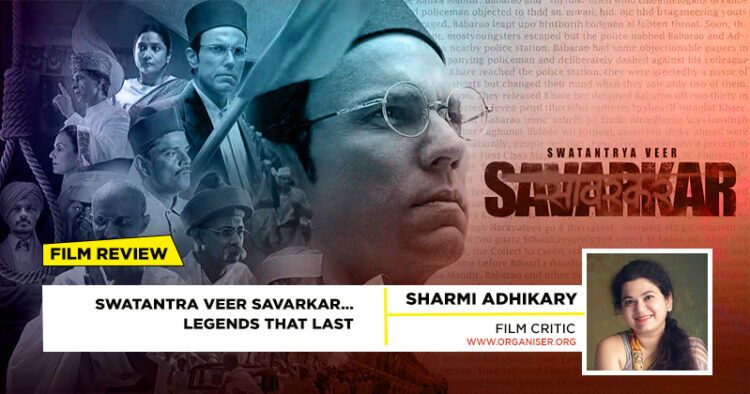It’s interesting how actor Randeep Hooda’s directorial debut, Swatantrya Veer Savarkar is performing at the box office. It had a tepid opening on day one of its release that coincided with a barrage of reviews by the mainstream media that called it ‘polarising’, ‘propagandist’ and ‘lacklustre’. Only a few publications lauded Hooda’s bravura in attempting to tell the story of one of Bharat’s prominent figures who convinced important British officers back then that the colonists were indeed wrong, severely wrong. Interestingly, the earnings picked up with strong word-of-mouth positive publicity and film trade analysts feel that Hooda might soon have a reason to smile when the Rs 20 crore movie breaks even. Godspeed to that!
The response to Hooda’s work is reminiscent of what happened to Vinayak Damodar Savarkar as well. A brave son of Mother India, he was thrown into a dungeon convicted to serve 50 years term of Kalapani as a political prisoner in the dreaded Cellular Jail at Andaman. The circumstances of his arrest prove that the British were waiting to put him behind bars using crooked means because the man had started weilding tremendous influence on the National Movement. In short, the Brits were extremely scared of what Savarkar was capable of. A fierce orator, a man with exceptional organisational skills and a personality who knew how to beat the Brits using their own codes of law, his rise had to be impeded if the colonists had to retain their power in India. At this juncture, Hooda’s research in the subject must be lauded. While the movie uses the tool of dramatisation, Hooda doesn’t take liberties with history while disseminating information. Referring to books such as Sanjeev Sanyal’s Revolutionaries and Vikram Sampath’s Savarkar consolidates the fact that what is shown in the movie is not a figment of imagination but a series of hard facts.
His release was marred by vicious propaganda against him fanned by not just the British but also politicians of the time who, in cahoot with the powers-that-be, ensured he was barred from joining active politics while spending a restrained life in Ratnagiri. But can lies curtail the truth? After years of being maligned at the altar of justice, truth and nationalism, Bharatiyas have after all recognised the true merit of the force that is VD Savarkar. Here’s hoping Hooda’s conviction, talent and hard work too gets its due credit clearing out the sham of deception, lies and conceit propagated by the left cabal who would love to peddle false narratives anyday in order to feed their selfish agendas.
One could possibly spend reams of newsprint to write about how history is duly represented in Swatantrya Veer Savarkar, but it would be better to inform oneself with substantial reading material. However, this is also where the film finds its first hiccup. The life and times of the luminary is so populated with significant events that to contain everything in 3 hours is a task of titanic proportions. Perhaps an OTT series would be a better proposition. However, that an attempt was made to take an unadulterated version of his story out to masses and for that a performer like Hooda, who is known to take up offbeat projects and giving his all to them, must be congratulated. Hooda the actor outshines all his earlier roles in this biopic. Hooda, the director (keep in mind that he took up the baton when the previous person on the job quit midway for fear of being categorised for directing a film on this ‘contentious’ figure by the liberal coterie. So much for freedom of speech!)… Well, we are coming to that in a bit.
If I were to prepare a list of reasons why a sachha Bharatiya must watch Swatantrya Veer Savarkar, I would probably start with the heart that Hooda puts into the performance. Right from the physical transformation to the onscreen act, he captivates the audience from the word go. While the first half takes some time to pick up, the second half is gritty and fabulous. Honestly, there could be a thousand films made on the atrocities meted out to the inmates of Cellular Jail by the British and the Islamic wardens, your mind would be numbed by the reality depicted through drama but to feel what the prisoners felt would never be possible. That sacrifice is a huge gift we got from them. Every scene relating the time Savarkar was incarcerated at Kalapani is a reminder of that sacrifice these nationalists made so that we breathe freely in our Motherland today. The scenes are difficult to sit through. They will make you angry and you might feel a lump in your throat. You will know why when you watch them. In fact, as was the revelations in Sanyal’s book, the film too brings forth the cases of Khudiram Bose and Madanlal Dhingra thus proving how our National Movement was marked by the blood of our brave patriots. Non violence was just one wing of the struggle that was spoken about because it suited the Congress after Independence.
And yet, Hooda was subtle. While unmasking the villainy of the British he cleverly hints at how radical Islamists used the place to convert Hindus in order to bring about a demographic shift. It was a sinister move. This was the truth that the actual propagandists termed as ‘Hindutva propaganda’ but I wonder how they would negate hard facts!
This could be a good time to mention that Savarkar wasn’t a radical. He was an idealist like many other revolutionaries of that time and was well versed with the obstacles Hindu leaders faced then while on one hand dealing with brutal British forces and Islamists on the other. And then there were the treacherous comfort loving ‘freedom fighters’ in your own ranks behind whom the Raj wasted enough money to keep up their sham of ‘poverty’ and ‘simplicity’. Not once does the director blatantly call out the ruse. The tone is sarcastic to the extent of being jovial (and cocky) so that the message is loud yet doesn’t upset insecure feathers. And this is achieved by intelligent writing that picks up steam in the second half. Enough opportunity is given to the audience to understand the balance with which Savarkar operated or thought, unlike the hypocritical machinations of men who were propped up as leaders to serve the cause of the British and the Muslims.
Breaking the fourth wall is a dramatic technique in theatre, films, TV and literature. It occurs when a performer acknowledges the audience, the camera, or any other observer. The “fourth wall” is the imaginary wall between the performers and audience. While the audience can see through this wall and observe the actors’ performance, the actors cannot. Technically in the film Hooda breaks the fourth wall and he does it with panache. However, the fine actor that he is, and how ahead of his times, he would probably have to wait for a while before the Indian mass audience takes to that style of performance or technique. But to do it with conviction takes courage and the artist must be lauded for it. The other high points of the film are the costumes, the casting, the cinematography and the music. Especially the music. Hitesh Modak and Shreyas Puranik’s tunes stir the soul. A special mention to the song Vande Mataram. It evokes not just love for the Motherland but profound respect for all the revolutionaries who shed their blood for her.
And now for the accusation (of writing mercy petitions) that Savarkar had to live all his life and even after he attained samadhi. Fifty years of incarceration in Cellular Jail was given to him not only to punish the man and take him out of public discourse. That could have been done by hanging him. The Brits didn’t do that. While they knew Savarkar knew the law well enough to beat them at their game, they actually wanted to kill the spirit of the man who just wanted a free Akhand Bharat, a land he worshiped like the Devi. He was no man to wallow in jail. He wanted to get out and fight for his country. The petitions were a by-product of that thought. Every injustice that was meted out to him was to suck the life force out of him. But the Devi destined it otherwise.
Tortured, lying unconscious in blood, urine and faeces, using the jail walls as slate he would write, memorise and erase verses daily. Fourteen years later he recollected all 6000 verses and composed his Mahakavya Kamala. Such was his unparalleled genius. The man suffered inhuman torture in Kalapani and most of it in solitary confinement, but he continued to fight the British while inspiring his fellow inmates and arguing in favour of their rightful dues. He identified Islamist forces and designed a way to protect Hindus from them. In Ratnagiri, Savarkar, a staunch debunker of the caste system, built the first Patit Pavan Mandir for Harijans and opposed any caste based discrimination. Hooda sheds light on all these nitty gritties in his brilliant directorial debut. In short, he proves emphatically that Vinayak Damodar Savarkar was a legend. And legends never die!




















Comments